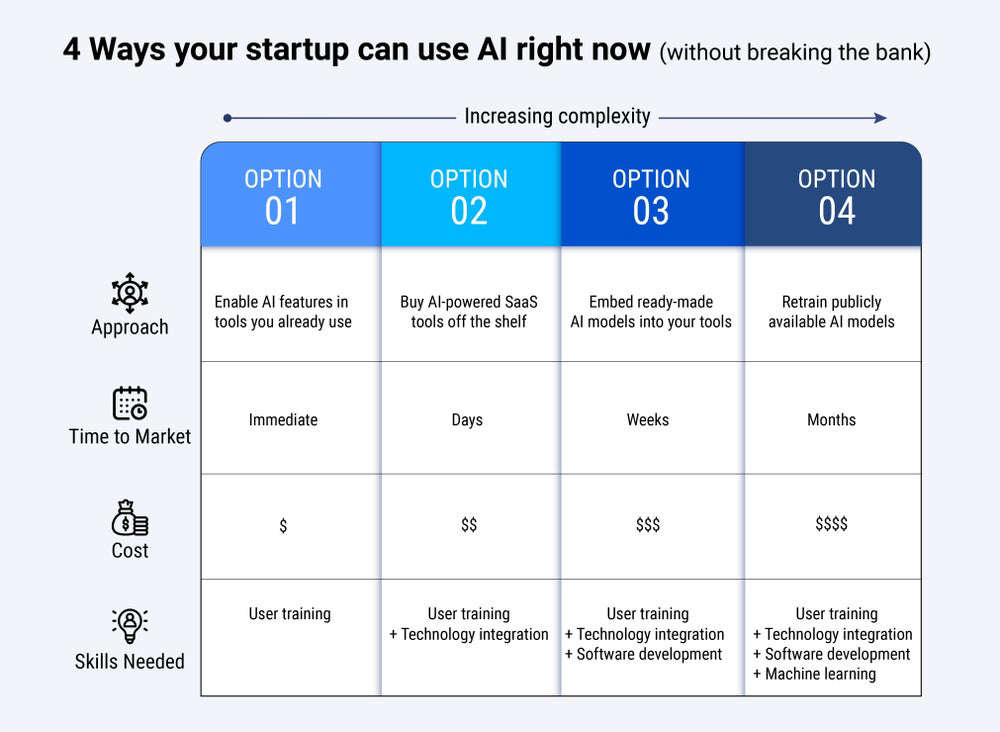Artificial intelligence (AI) is what computer scientist Andrew Ng calls “the new electricity.” However, despite its abilities and appeal, AI is not a fit for every situation. In my earlier article, I presented 5 scenarios to avoid investing in AI. To find out if your startup needs AI, start by prioritizing your business problems. Frame the best approach to solve these challenges and evaluate how technology can help you. Most of the time, basic analysis, statistics, or simple machine learning can do the job effectively.
A few situations do warrant the horsepower of AI. In those scenarios, the additional intelligence and automation can be transformational for your startup. This article is for those cases.
When you’ve sensed the need, the next common question is “Do I really need a big budget to use AI?” No, your business doesn’t need months of effort, elite data scientists, or even big-ticket budgets to become AI-driven.
Here are 4 ways your startup or SME (small or medium-sized enterprise) can start using AI today. These suggestions are sequenced from the easiest to the hardest, so start at the top and find out which option best meets your needs.
1. Enable AI features in tools you already use
AI is all around us. Your smartphone probably has at least a dozen apps that use AI. This technology enables your camera to take better pictures, helps organize your photos, and powers your curated social feeds.
Most enterprise tools are adding AI-driven features to their products. Microsoft has rolled several AI capabilities into Excel. When you insert data from screenshots or leverage insights suggested by the Ideas panel in Excel, you are using AI. Salesforce has integrated Einstein, its AI engine, as an intelligent assistant across its popular CRM (customer relationship management) platform. While some firms bundle AI features into their core product offerings, others may need an upgrade.
Ask vendors if the software you’ve bought has AI capabilities. Chances are your existing toolset could already be AI-driven or enabled with a quick upgrade.
2. Buy AI-powered SaaS tools off the shelf
Today, an overabundance of SaaS (software as a service) tools are available at affordable monthly subscriptions. Do you want to polish your marketing copy? Grammarly’s nifty copy-editing features can help you cover good ground. Want to transcribe your customer testimonial videos or do professional-grade media editing? Descript’s AI features can make this a breeze.
When you have an unmet business need, scout for functional SaaS tools that are powered by intelligent capabilities. Most of them come with ready integrations and easily plug into your existing IT ecosystem. Even if they aren’t a perfect fit, what matters is whether they can solve the majority of your problems. If so, you can avoid investing in expensive enterprise licenses for similar AI capabilities.
Evaluate the tools available against your key requirements. Find out the extent of the match and the ease of integration. If the result is over an acceptable threshold, you can go ahead.
3. Embed ready-made AI models into your tools
When you can’t find tools with in-built intelligence, the next best option is to look for AI models in the cloud that can connect to your tools. For example, if you’re trying to spot manufacturing defects in your products, you can use AI to automate the visual inspection. Amazon Lookout for Vision is a machine learning (ML) service on the cloud that directly plugs into your workflow.
Unlike the earlier steps, this one calls for DevOps (software development and IT operations) capability. Although you don’t need data scientists, your team must have programming expertise to link your software application to online AI models. Pay attention to the subscription costs, which are often based on usage volume.
To explore this option, identify online ML platforms that have pre-built AI models to solve your domain problem. This space has offerings from promising startups such as Clarifai, Dialogflow, and SightHound, plus larger players such as Microsoft, Google, and Amazon.
4. Retrain publicly available AI models
When you’ve exhausted the above options, it’s time to train AI models in-house using data scientists. Rather than starting from scratch, you can conserve effort by reusing publicly available AI algorithms and readily curated datasets. They can be adapted to solve your problem.
Let’s say your startup needs to understand customer satisfaction by analyzing text feedback from customer surveys. You need algorithms with natural language processing (NLP) capability. Rather than painstakingly training fresh AI models, your teams can build upon the work of award-winning models in public contests such as Kaggle, DrivenData, or AICrowd.
The best things on the internet are often free, but finding them takes time. Look for open repositories such as HuggingFace that publish their models with pre-trained weights, or communities such as PapersWithCode that make ML models public. Most of these websites share rich, curated data that provide a jumpstart for your model-building process. Have your team assess the efforts needed to adapt the public models and determine the costs of maintaining them in production.
Being AI-driven is a journey, not a destination
We’ve looked at 4 ways you can get started with AI and make the most of your resources. While it’s often easy to begin the AI journey, getting consistent business value will require continuous attention and investment.
You need to train your users, retool your organizational workflows, and manage the cultural change associated with AI. It is critical to revisit periodically the total cost of ownership (TCO) of your AI investment. The option that works for you today might become expensive after a year.
For example, subscribing to an AI-driven SaaS tool (option #2) may suit a small team serving an initial customer base. As your team scales and the usage volume increases, subscription costs can become exorbitant. At that stage, you might find it more economical to hire a small team of data scientists and retrain publicly available AI models (option #4).
To streamline your AI decision-making, here’s a summary of the options at your disposal:

The post 4 Ways Your Startup Can Use AI Right Now (Without Breaking The Bank) appeared first on Entrepreneur
Original source: Entrepreneur






